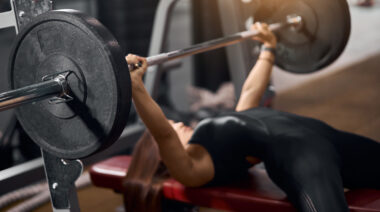Many athletes experience low back pain during lifting. Poor technique when performing deep squats places excessive stress on the low back. In the strength community, debate encircles the amount of pelvic motion allowed during these movements.
Years ago, I wrote an article on low back stress during squats in which I asserted that, particularly with heavy weights, there should not be full pelvic tilting. This sparked serious debate. I didn’t say that no one should squat butt-to-floor, but that each individual is individual. Everyone has soft tissue, anatomical, and structural differences. Ignoring these variations is idiotic!
This is especially true in a population that doesn’t move into this range of motion. For example, a swimmer barely moves into full hip flexion, so why increase their low back stress with a deep squat if they can’t squat correctly (with a flat back)? The same thing applies for baseball players, numerous other athletes, or regular gym rats.
You need to gauge your preparedness for butt-to-grass squats. [Photo credit: CrossFit Empirical]
Many will argue going butt-to-floor doesn’t increase stress on the low back, because this is how caveman used to squat, so it is a natural movement. Well, unless you’ve been shitting in the woods for 20 years, chances are you haven’t maintained that natural motion.
Individualization is what dictates movements in my gym, not just because someone said so. Pass the tests below, and you can go butt-to-floor. If not, why place the excessive stress on your lumbar spine?
Squat Butt-to-Floor: Straight Leg Raise
This is an easy test anyone can do on their own at home. Lie on your back, bend one knee, then raise your other leg while keeping it straight. While doing this, place the fingers of one hand under your low back. Feel where your back begins to press into your hand. During this sagittal plane test, we are determining if the hamstrings are tight and if they are going to rock your pelvis back into your hand.
If you have a buddy, have them raise your completely relaxed leg and assess when your low back places pressure on your hand. If your partner can raise your leg much higher before your hand hits your back than you could on your own, then you have some soft tissue restrictions. Find a local physical therapist who can work on this deficit or become best friends with a lacrosse ball or Olympic bar.
If you have the same range by yourself or with a partner lifting your leg, then you may have an anatomical block preventing you from going butt-to-floor. You need to clear these range of motion deficits before going butt-to-floor.
Squat Butt-to-Floor: Scour Test
Another test for determining hip anatomical blocks is the scour test. This test is primarily used by physical therapists, but one you can do with your training partner. In this test, the partner flexes the hip and knee, then applies a downward pressure on the thigh while circumducting the thigh inward. The partner can feel when it hits a hard restriction like a bone, likely the acetabulum. When rotating the thigh, there may be less resistance or more range of motion; this is due to the shape of the acetabulum.
This test helps diagnose injuries in the hip, as well as hip architecture. If you have a deep acetabulum or pain, you are not starting with deep butt-to-floor squats. During this test, if you experience pain or pinching, this is suggestive of hip labral damage.
Squat Butt-to-Floor: Quadruped Rock Back
The quadruped rock back determines when the femurs begin to rotate the pelvis and how thigh distance alters pelvic motion. Sit on all fours, then rock your hips and rear back. As you begin sitting back, notice when your pelvis starts to rock. First do this with your knees shoulder width apart. Next, do it with your hips open wider. Most people can sit back further with their hips wider before their pelvis begins to rock, again due to the shape of the acetabulum.
If your pelvis moves extremely early, you are not starting with butt-to-floor squats, as you likely have deep hip sockets or are lacking hip joint space.
Squat Butt-to-Floor: FABER Test
The FABER test helps diagnose sacroiliac joint pain and range of motion deficits. Lie on your back and place your foot directly above your opposite knee. Next, drop your knee towards the outside of the table. If your knee can drop and be parallel to the table, that’s a good sign. You can also have a partner move your hip towards the outside. If there are restrictions while dropping the knee out, you may have tight hip flexors. Moreover, if you have pain in your low back or SIJ, you will have a higher risk of low back stress during a “rear wink.” If you have pain or extreme range of motion deficits, you need to work on this first before squatting butt-to-floor.
Are You Ready for Butt-to-Floor?
If you can’t pass these four tests, you shouldn’t be starting with butt-to-floor squats. You need to first improve your body and give it the tools to squat deeper. Some people’s anatomy will prevent them from ever squatting butt-to-floor. If you don’t pass these tests, you are placing yourself at a higher injury risk by squatting too deep. Don’t be a lemming and do what everyone else is doing. Take a few minutes, assess your body, and implement a plan for improvement, or start Yelping a good physical therapist.
Make the squat work for you:
Hips Don’t Lie: 4 Drills to Unlock Your Stiff Hips
Learn how to cue your athletes:
When Good Cues Go Bad






